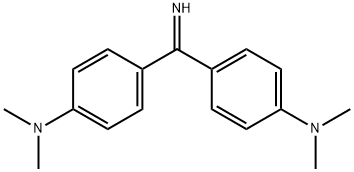???? C??? ??, ??, ??
??? ??
Auramine is a yellow crystalline powder or
flaky material.
??
Yellow dye for paper, textiles, leather; antisep-
tic; fungicide.
??
ChEBI: A member of the class of imines that is benzophenone imine carrying two dimethylamino substituents at positions 4 and 4'. The hydrochloride salt is the biological stain 'auramine O'
?? ??
(a) will Sulphur dissolved in 4-(4-(Dimethylamino)benzyl)-N,N-dimethylbenzenamine?methane. Add in ammonia and sodium chloride, ammonia in 175 ℃ heat the mixture, with hot water extraction dye and salting out (GP53614); (b) Bis (4 – (dimethylamino) phenyl) methanone and ammonia and Zinc chloride in a total of 150 ~ 160 ℃ heat (GP 29060). Free base is to add the same amount of naoh aqueous solution hydrochloride, sodium carbonate and ammonia and have to.
?? ??
Yellow crystalline powder or yellow needles.
?? ???
Yellow pyoctanine neutralizes acids in exothermic reactions to form salts plus water. May be incompatible with isocyanates, halogenated organics, peroxides, phenols (acidic), epoxides, anhydrides, and acid halides. May generate hydrogen, a flammable gas, in combination with strong reducing agents such as hydrides.
???
Confirmed carcinogen.
????
Inhalation of material may be harmful. Contact may cause burns to skin and eyes. Inhalation of Asbestos dust may have a damaging effect on the lungs. Fire may produce irritating, corrosive and/or toxic gases. Some liquids produce vapors that may cause dizziness or suffocation. Runoff from fire control may cause pollution.
????
Some may burn but none ignite readily. Containers may explode when heated. Some may be transported hot.
???
Fungicide: Auramine is used industrially as a dye or dye intermediate for coloring textiles, paper, and leather. Also
used as an antiseptic (a powerful antiseptic in ear and nose
surgery and in gonorrhea treatment)
???
WAXOLINE YELLOW O®
??? ??
Auramine is used industrially as a dye
or dye intermediate for coloring textiles; paper, and leather.
Also used as an antiseptic (a powerful antiseptic in ear and
nose surgery, and treatment of gonorrhea) and fungicide.
Human exposure to auramine occurs principally through
skin absorption or inhalation of vapors. Low-level dermal
exposure to the consumer may occur but would be limited
to any migration of auramine from fabric, leather, or paper
goods.
?? ??
UN2811 Toxic solids, organic, n.o.s., Hazard
Class: 6.1; Labels: 6.1-Poisonous materials, Technical
Name Required. UN3143 Dyes, solid, toxic, n.o.s. or Dye
intermediates, solid, toxic, n.o.s., Hazard Class: 6.1;
Labels: 6.1-Poisonous materials, Technical Name Required.
? ???
Incompatible with oxidizers (chlorates,
nitrates, peroxides, permanganates, perchlorates, chlorine,
bromine, fluorine, etc.); contact may cause fires or explosions.
Keep away from alkaline materials, strong bases,
strong acids, oxoacids, epoxides.
??? ??
Consult with environmental
regulatory agencies for guidance on acceptable disposal
practices. Generators of waste containing this contaminant
(≥100 kg/mo) must conform with EPA regulations governing
storage, transportation, treatment, and waste disposal.
Incinerate in furnace with afterburner and scrubber.
???? ?? ?? ? ???
???
?? ??









